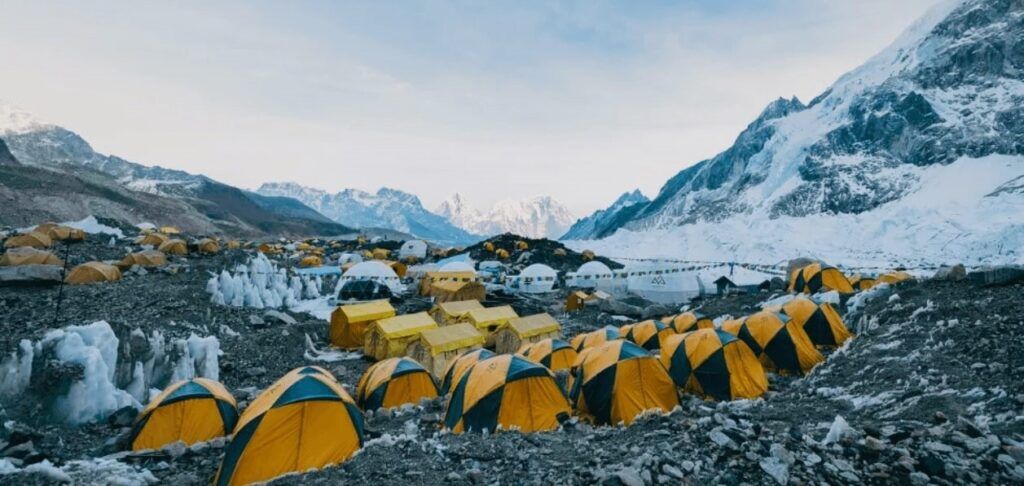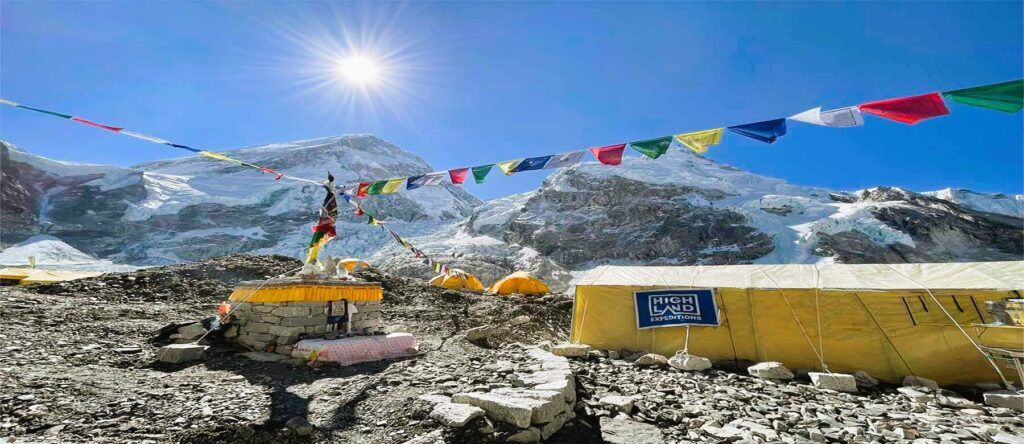Mount Everest is the crown jewel of the Himalayas, and it shares its location with China and Nepal. This raises the question: How many camps are on Mount Everest? The Southern Approach is located in Nepal, whereas the Northern Approach lies in Tibet, China.
So, how many camps are there on Everest? The answer depends on which countryside of the mountain you’re tackling.
The Southern approach (Nepal) has camp 1 (6,065 meters/19,900 ft), camp 2 (6,400 meters/21,300 ft), camp 3 (7,200 meters/23,600 ft), and camp 4 (7,920 meters/26,000 ft). The Northern approach (Tibet) has north base camp (5,150 meters/16,900 ft), intermediate camp (6,400 meters/21,000 ft), advanced base camp (6,500 meters/21,300 ft), and camp 6 (7,790 meters/25,558 ft).
If you’re still wondering, how many camps are located on Mount Everest? or how many Base Camps are on Mount Everest? This blog will answer all your questions in detail.
Exploring Mount Everest Camp
These are the standard set of camps for both the south and north sides. Climbers exploring Mount Everest camp with different routes or using variations in their strategies might use additional camps depending on their specific needs and chosen path.
No matter which side you choose, conquering Everest requires planning, extreme fitness, and a healthy dose of courage. Regardless, the south approach for the Everest Base Camp is considered more safe than the northern approach.
Evolution of Base Camps Over Time
Early climbers on Everest relied on shelters in villages. These were often basic tents made from canvas or animal skins, offering minimal protection from the harsh elements. Fast forward to the present trekking era; base camps have evolved into temporary tented villages, with some resembling small outposts. These offer multiple tents for sleeping, dining, and socializing.

How Many Camps Are on Mount Everest?
The South Col Route (Nepal) typically uses 4 camps after reaching South Base Camp. The North Col Route (Tibet) usually has 3-4 main camps after North Base Camp. The exact number can vary depending on the chosen route.
Camp I
Camp 1 (6,065 meters/19,900 ft) is the first stop on the ascent, offering climbers their first taste of high altitude.
Camp II
Camp 2 (6,400 meters/21,300 ft) is also known as Advanced Base Camp; this is where climbers typically spend more time to acclimatize further.
Camp III
Camp 3 (7,200 meters/23,600 ft) has the steeper terrain and the air thinner here. Climbers typically make a push to reach camp 4 from here.
Camp IV (Summit Camp)
Camp 4 (7,920 meters/26,000 ft) is the highest camp on the south side, also known as the “Death Zone” due to the extremely harsh conditions. Climbers use this camp as a launchpad for their summit push.
What are the Challenges and Risks Associated with Setting Up Camps?
Environmental Challenges
- Wind, rain, snow, and extreme cold temperatures on Everest can make setting up camp difficult and staying comfortable challenging.
- Finding flat, stable ground for your tent can be tricky, especially on rocky or sloped surfaces.
- Access to clean water and firewood might be scarce, so proper planning and resource management are essential.
Logistical Obstacles
- Camping equipment, especially tents and backpacks, can be bulky and heavy to carry, especially on long hikes.
- Setting up a tent properly, especially in windy conditions, requires some practice and knowledge.
- Help might be far away in case of emergencies or unexpected situations. Self-reliance and good planning are key.
- While these challenges exist, with proper planning, knowledge, and choosing the right location, setting up camp can be a safe and rewarding experience. Always prioritize safety, be prepared for the unexpected, and leave no trace behind to respect the environment.
Exploring Mount Everest Base Camps
Everest has two main starting points: the South Base Camp in Nepal and the North Base Camp in Tibet. South Base Camp (Nepal) is more crowded and easier to reach. Nestled in the Khumbu Valley, it’s a bustling village with tents for food, sleep, and medical care. North Base Camp (Tibet) is less crowded and more remote. Situated on the high Tibetan Plateau, it offers a different kind of beauty and a chance to see the world’s highest monastery.

1. The Southern Approach: The Classic Route
The south side of Everest, located in Nepal, is the most popular route for climbers. Which includes the following base camps:
- South Base Camp (5,364 meters/17,598 ft)
- Camp 1 (6,065 meters/19,900 ft)
- Camp 2 (6,400 meters/21,300 ft)
- Camp 3 (7,200 meters/23,600 ft)
- Camp 4 (7,920 meters/26,000 ft)
2. The Northern Approach: A Different Challenge
The north side of Everest lies in Tibet, China. While less frequented, this route also has a series of camps:
- North Base Camp (5,150 meters/16,900 ft)
- Intermediate Camp (6,400 meters/21,000 ft)
- Advanced Base Camp (6,500 meters/21,300 ft)
- Camp 6 (7,790 meters/25,558 ft)
What are the Facilities Provided by Each Base Camp?
South Base Camp (Nepal)
- Think tents for sleeping, eating, and basic medical care.
- Experience Sherpa hospitality with opportunities to interact and learn about their traditions.
- Choices for food and other supplies might be more limited compared to the north side.
North Base Camp (Tibet):
- Expect a more basic setup with essential tents for accommodation.
- Explore the Rongbuk monastery, the world’s highest, for a unique cultural experience.
- Due to easier access for supplies, there might be a wider range of food and basic gear available for purchase compared to the south side.
What is the Importance of Base Camps for Climbers?
Base camps are like essential stops for climbers. They’re safe havens built at a comfortable altitude where climbers can rest, eat, and get ready for the big push to the summit. Imagine them as mini-camps with tents for sleeping and eating, sometimes even medical care. These camps are crucial for acclimatization, slowly adjusting your body to the thin air at high altitudes, which helps prevent altitude sickness and keeps you safe for the challenging climb ahead.
How to Reach Everest Base Camps?
There are two main starting points for reaching Everest Base Camp, depending on which side of the mountain you choose: Nepal (South Col Route) or Tibet (North Col Route). The most common way to reach Everest Base Camp in Nepal is to fly into Lukla (2,866 meters/9,400 ft), a small mountain town often called the “Gateway to Everest.” Lukla Airport is known for its short runway and challenging landing conditions due to its location in the Himalayas.
Your journey to Everest Base Camp on the Tibetan side begins with a flight to Lhasa, the capital city of Tibet (3,656 meters/11,998 ft). Lhasa offers a unique cultural experience with its Tibetan buddhist monasteries and historical sites like the Potala Palace.
Choose Tidy Himalaya?
Tidy Himalaya has been providing top-notch service to its clients regardless of the size of the group, physical fitness, and experiences. Apart from Everest Base Camp Trek, Tidy Himalaya offers the Annapurna Circuit trek, the Mardi Himal Trek, the Culture Tour of Nepal, and many more.
We also offers its service in Bhutan, India, and Tibet. Book the best holiday packages with Tidy Himalaya and experience the best and most exciting holiday.
Experience and Reputation
Tidy Himalaya has established a reputation for providing exceptional service to its clients. Tidy Himalayan staff is highly experienced in their respective fields, and their dedication to their clients is evident. This commitment to quality has earned Tidy Himalaya a loyal following and the respect of customers.
Licenses and Certifications
Tidy Himalaya, a certified trekking company, elevates your Himalayan adventure with its team of highly-trained and licensed guides. Tour guides’ deeper knowledge of the region ensures a safe, unforgettable experience and beautiful insights into the places.
Safety Standards
You’ll be accompanied by certified guides who can navigate the wilderness and manage potential risks. Tidy Himalaya companies offer essential gear rentals or advise on the appropriate equipment for the trek and weather conditions.
Customizable Itineraries
The itinerary can be customized based on your level of fitness and experience. The trek itinerary will be designed with acclimatization in mind. The gradual ascent allows your body to adjust to the thinner air at high altitudes, reducing the risk of altitude sickness.
FAQs:
How many camps does it take to climb Mount Everest?
To conquer Everest, you’ll need a series of camps. On the south side (Nepal), expect 4 camps after base camp. The Northside (Tibet) usually has 3-4 main camps. The number can vary slightly depending on the route chosen.
Is there a camp 3 on Everest?
Yes, there is a Camp 3 in both Nepal and Tibet. The South Col Route (Nepal) sits at roughly 7,200 meters (23,600 ft). It is a crucial stopping point for climbers before attempting the summit push from Camp 4 in the infamous “Death Zone.” North Col Route (Tibet) sits at a similar altitude (around 7,400 meters or 24,278 ft) for climbing Mount Everest, located in Tibet.
How high is Camp 4 on Everest?
Camp 4 on Mount Everest, also known as the South Col High Camp, sits at a staggering 7,920 meters (26,000 feet) above sea level. This makes it the highest camp on the standard climbing routes on both the South Col Route (southern Nepal) and the North Col Route (northern Tibet).
Can you see Everest from Camp 1?
No, seeing Mount Everest from Camp 1 on the South Col Route (southern Nepal) is not guaranteed. Camp 1 is typically located around 6,065 meters (19,900 ft) on the Khumbu Glacier. While this is a significant altitude, the surrounding mountains and potential weather conditions can obstruct Everest’s summit view.
What is the death zone on Mount Everest?
The death zone on Mount Everest refers to the region above 8,000 meters (26,247 feet) where the atmosphere becomes so thin that it’s extremely difficult and dangerous for humans to survive for extended periods. The lack of oxygen creates a harsh environment that pushes the human body to its limits.
Can you fly to Camp 4 Everest?
No, flying directly to Camp 4 on Mount Everest is not possible. Camp 4 sits at a staggering 7,920 meters (26,000 feet), which is well beyond the operational limits of helicopters. The thin atmosphere at such high altitudes significantly reduces lift, making safe helicopter flight impossible.


.webp&w=1200&q=75&dpl=dpl_GkDHrWHoqvfbyW4EwcXcrQqzpAbH)
.webp&w=1200&q=75&dpl=dpl_GkDHrWHoqvfbyW4EwcXcrQqzpAbH)
.webp&w=1200&q=75&dpl=dpl_GkDHrWHoqvfbyW4EwcXcrQqzpAbH)